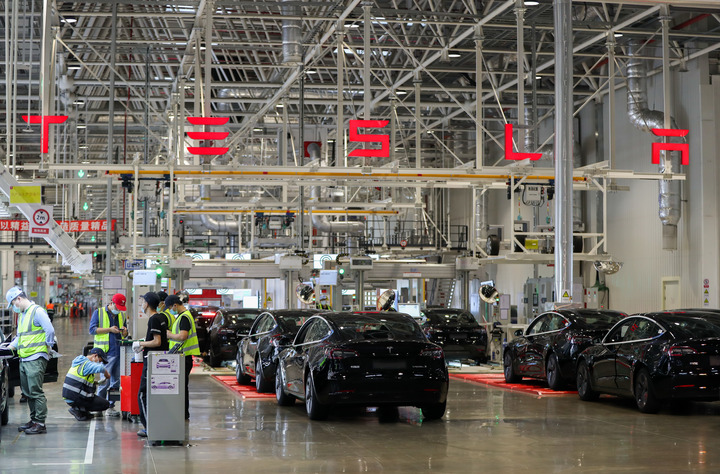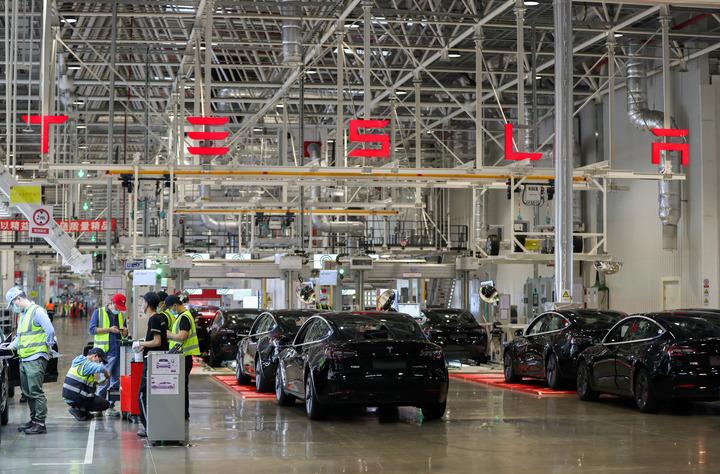
Employees work at the Tesla Gigafactory in Shanghai, east China, Nov. 20, 2020. (Xinhua/Ding Ting)
BEIJING, July 14 (Xinhua) -- From January to May this year, China's actual utilized foreign capital amounted to 564.2 billion yuan with a year-on-year increase of 17.3 percent. Compared with the same periods historically, the growth rate of utilized foreign capital remains high, and China's momentum of steadily growing foreign investment remains unchanged, said Shu Jueting, spokesperson of the Ministry of Commerce.
-- Multinational companies stay optimistic about Chinese market
A number of multinationals recently enlarged their investment in China. On May 31, Merck, a technology company, announced its investment in constructing an advanced semiconductor integration base in Zhangjiagang, Jiangsu Province for further localization. On June 23, BMW Brilliance Plant Lydia officially opened in Shenyang, Northeast China's Liaoning Province with a total investment of over 2 billion euros, which is so far the biggest single investment of BMW in China.
Since the beginning of this year, a number of multinational companies including BMW expedited their investment layout in China, showing their confidence in the Chinese market and optimistic attitude towards long-term development of China, added Shu Jueting, pointing out that in the first five months of 2022, 54.3 percent of the total actual utilized foreign capital in China was from the big foreign investment projects with the contractual amount over 100 million U.S. dollars, which registered 47.68 billion U.S. dollars, recording a year-on-year increase of 40.3 percent.
China's momentum of continuously attracting foreign investment becomes more prominent in global context.
According to a report recently published by the Chinese Academy of International Trade and Economic Cooperation (CAITEC), anti-globalization and trade protectionism discouraged investment of multinationals. However, China bucked the trend to maintain the stability of foreign capital. In 2021, the actual utilized foreign capital of China's manufacturing sector reached 33.73 billion U.S. dollars, up 8.8 percent year on year and 1.1 percentage points higher than the global manufacturing FDI growth rate.
On June 15, Shanghai issued certificates to 30 newly certified regional headquarters and 10 R&D centers of multinationals. Up to now, there are 848 multinationals' regional headquarters in Shanghai.
-- Foreign investment structure further improved in China
With its R&D staff in China increasing by 30 percent over the past three years with the total number exceeding 1,800, and obtaining more than 1,800 patents, Schneider Electric has made R&D and innovation the key words of its development in China.Yin Zheng, Executive Vice President, China Operations of Schneider Electric, noted that through establishment of China Center combining technology, R&D and sales support, the company greatly shortening the time of product launch.
As China keeps advancing the transformation and upgrading of its manufacturing sector, the multinationals' investment shows a trend of extending to high-tech manufacturing business and high-value-added production. Statistics showed from 2017 to 2021, the actual utilized foreign capital in China's high-tech manufacturing sector grew from 9.89 billion U.S. dollars to 12.06 billion U.S. dollars, and its share in that of China's entire manufacturing industry expanded from 29.5 percent to 35.8 percent. Green and low-carbon manufacturing is more favored by foreign capital than the labor-intensive, energy-intensive and high-polluting sectors.
-- New competitive advantage is taking shape
Many multinationals attributed their settle-down in China to the abundance and lower costs of various production elements. As China's economy grows, workers get higher pay and the advantage of the country's low labor cost starts to fade away. However, multinationals' investment will never cease because of China's overall business attractiveness.
The optimizing supply chain of China's manufacturing sector becomes its new competitive advantage. China owns 41 big categories, 207 medium categories and 666 small categories of industrial products, making it the only country to have all the industrial categories listed in the International Standard Industrial Classification (ISIC), according to the CAITEC report. Such supply chains formed by highly professional labor divisions and large-scale collaboration are quite resilient and can be quickly repaired or rehabilitated even under impact.
"China's whole-industry-chain advantage is a critical factor in attracting the investment of capital-intensive enterprises", said Yu Miaojie, Deputy Dean of National School of Development at Peking University, in an interview. Labor cost is merely one of the reasons for site selection and investment for capital-intensive enterprises, which would attach more importance to both upstream and downstream parts as well as the completeness of the categories on the industrial chains.
(Edited by Bao Nuomin with Xinhua Silk Road, baonuomin@xinhua.org)




 A single purchase
A single purchase









